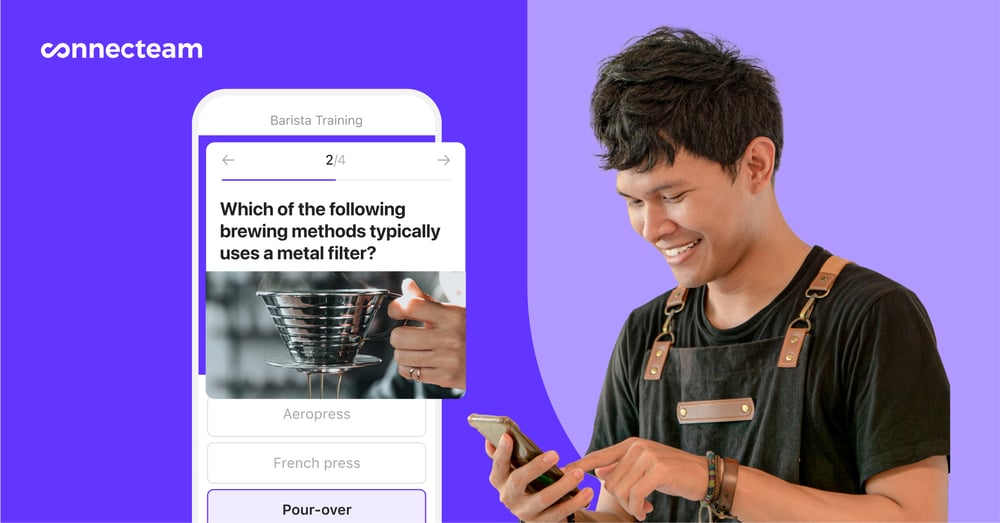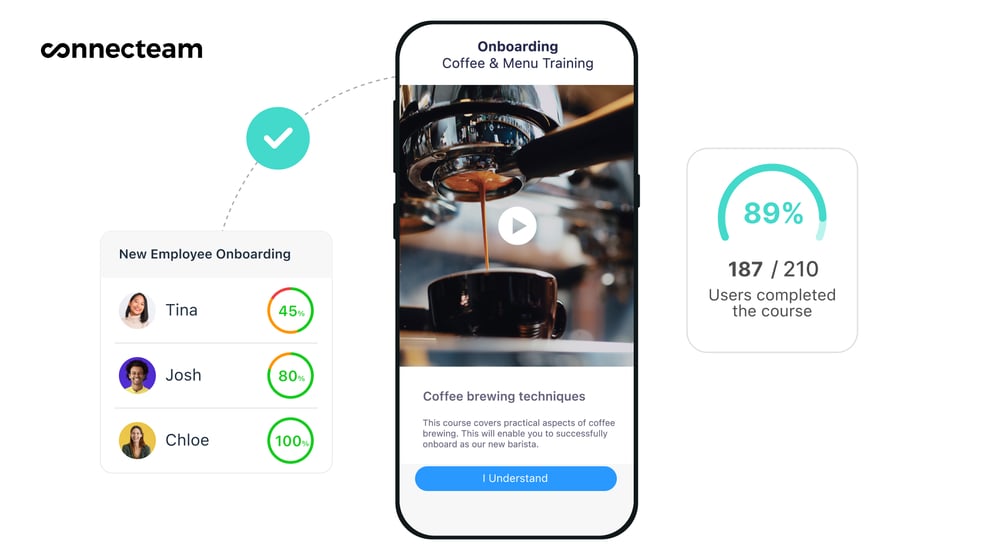Good employee learning and development increases productivity, leads to higher-quality work, boosts engagement, reduces turnover, and more. In this guide, we explain why employee learning is important and how you can build a successful training and development program for your workers.
Ineffective employee learning is a lose-lose situation for your company and your workers. Poorly trained workers are less productive and make more mistakes—leading to lower customer satisfaction, compliance issues, and more. What’s worse, even your best workers are unlikely to stick around if you don’t provide them with good career development opportunities.
That’s why building an effective employee training and development program is essential. This is a great way to keep employees skilled, engaged, and productive. Plus, a well-trained workforce helps enhance your reputation in your industry and bring you more business.
In this guide, we look at what employee learning and development is and why it’s important. We also share our top tips for creating a successful training and development program so you can build one for your company today.
Key Takeaways
- Employee training focuses on providing workers with specific skills and knowledge, while development programs focus on employees’ long-term growth and career development.
- A good training and development program improves productivity, work quality, and employee engagement levels. It also reduces turnover and helps eliminate skills gaps.
- You need to identify the right topics and use effective delivery methods to run a successful training and development program.
- Software like Connecteam lets you build, manage, and track your employee learning and development sessions from a single platform.
Understanding Employee Learning and Development
Employee learning and development both focus on enhancing workers’ skills, abilities, and knowledge. However, while training and development are related, they’re different concepts with distinct purposes. Let’s break them down.
Training
Training, or learning, is the process of providing workers with the specific knowledge and skills they need for their roles. Focused on the short term, training aims to close skills gaps, improve performance, and enable workers to carry out their tasks effectively.
Training usually follows a structured approach to learning. It can include online courses, classroom learning, on-the-job learning, job shadowing, workshops, and hands-on practical exercises.
In addition, training content typically focuses on topics specific to the industry or role. Topics can range from basic concepts, like safety or product training, to more advanced subjects, like training on programming languages or proper equipment usage.
Development
On the other hand, development focuses on employees’ growth and professional development in the long term. Common development activities include mentoring, coaching, and job rotations. They allow for a one-on-one relationship between the trainer and the employee.
Unlike training, development programs go beyond job-specific skills and abilities. They aim to improve long-term competencies like talent management, leadership, emotional intelligence, strategic thinking, and more.
The goal of development programs is to nurture a worker’s potential, guide them to contribute to organizational goals, and prepare them for different roles at the company in the future.
What Are the Benefits of Employee Training and Development?
Improves productivity, performance, and sales
Skills training can equip workers with everything they need to do their jobs effectively. With the right knowledge and abilities, they’re more likely to work faster, be more productive, and make fewer mistakes. This leads to your team getting more work done, which can improve your bottom line.
In fact, a study by the American Society for Training and Development found that training increased revenue by 218% per worker. Plus, companies that invested in training reported 24% higher profit margins versus companies that didn’t prioritize employee learning.
Training employees also improves the quality of your team’s work. This helps solidify your credibility with current customers and attract new business, further boosting your profitability.
Encourages growth and innovation
When workers are well-trained in their daily roles, they have more bandwidth to think about ways to improve their workflows and develop new ideas that can benefit your company.
Likewise, learning new technologies through training can help your workers develop efficient and creative solutions to problems. This can give your company an advantage over competitors in the market.
Reduces skills gaps and talent shortages
McKinsey reported that nearly 90% of managers and leaders already have or expect skills gaps to develop in their companies. The US is also seeing a talent shortage in the job market, making it harder to hire external talent to bridge these gaps.
Good employee training and development is a great way to reskill and cross-skill your workers. By doing this, you can use your existing workforce to fill knowledge gaps in your company. You won’t have to spend time, effort, and money hiring new employees.
📚 This Might Interest You:
Quiet hiring is a recruiting strategy where companies fill talent gaps without hiring externally. Read our complete guide on quiet hiring and how to implement it correctly.
Increases employee engagement, satisfaction, and retention
Studies show that training and development programs improve employee engagement and satisfaction levels. This is because good learning programs help workers feel confident in their skills and motivated to grow within the company.
Additionally, some workers believe that professional development is the best way to improve company culture. A stronger company culture leads to increased team morale and higher employee satisfaction, which can help boost engagement even further.
Moreover, another study found that over 75% of respondents would stay in their company for continuous learning and development opportunities. Workers who are given ample opportunities to grow in-house are unlikely to search for it elsewhere. This makes it easier to hold on to your top talentlong-term.
📚 This Might Interest You:
We explain how to calculate your employee retention rate and share the most effective retention strategies for 2025.
Keeps you compliant
Many companies need to follow industry-specific standards and regulations in their working practices. For instance, construction workers have to adhere to strict health and safety guidelines on the job. Similarly, employees handling food must follow hygiene protocols and conduct the right quality checks.
Effective learning and development programs keep employees up to date with applicable laws and regulations. This keeps your company compliant and ensures safety for both workers and customers.
📚 This Might Interest You:
Check out our full guide on compliance training—including why it’s important and the best tools to run your compliance training program.
Types of Employee Training and Development
Training
Training focuses on specific skills and competencies. These could be job-specific, linked to a particular company working practice, or related to the overall industry.
Here are some examples of training topics:
- New hire onboarding
- Compliance training
- Customer service training
- Technical training—e.g., how to use machinery and tools
- Health and safety training
Training can be delivered in many different ways. The most commonly used training methods are listed below.
Instructor-led or classroom-style training
In this method, a live instructor conducts the training session and presents material to workers. This has the benefit of live interaction and discussion. But, it’s more expensive since you have to rent a space, pay trainer fees, account for travel costs, and more.
💡 Pro Tip:
Many companies today conduct classroom sessions virtually through video conferencing apps. It’s more cost-effective, and workers can attend sessions from anywhere. However, the main downside is that there’s no easy way to check if workers are paying attention to the content.
E-learning

E-learning, or online learning, uses digital tools to create and deliver training to learners. With a platform like Connecteam, you can build interactive training courses online. Your workers can access them from anywhere using their desktops, tablets, and smartphones and complete them at their own pace.
Although e-learning doesn’t have live interaction, many platforms (including Connecteam) let you add quizzes to make learning fun and engaging.
💡 Pro Tip:
Microlearning—breaking courses into bite-sized sections—enables better knowledge retention, especially in online learning. Read our full guide on the best microlearning platforms on the market.
Training materials and guides
Training manuals and SOPs (standard operating procedures) help workers learn skills and information specific to their roles at a company. These guides contain detailed instructions that help employees perform their jobs effectively and follow business rules.
For instance, you could create a training manual that explains how a piece of equipment works or an SOP document that details how to open your business for the day.
🧠 Did You Know?
You can securely store your training guides, SOPs, and more using Connecteam’s knowledge base feature. It offers unlimited storage and no restrictions on file size. You can even add images, videos, audio clips, and more. Workers can access materials instantly from anywhere using their mobile or desktop devices!
Job shadowing
Job shadowing lets one employee follow another worker—preferably an expert in the role—and learn the job from them. This is a great way to encourage on-the-job learning without leaving learners in the deep end or putting your company’s product or services at risk.
💡 Pro Tip:
Use blended learning—a combination of classroom, online, and on-the-job training —to enhance learning.
Hands-on workshops
Workshops provide a hands-on learning experience. In this method, learners are given live demos of how to use the tools, machinery, software, etc., they need for their jobs. This allows employees to practice new skills in a controlled environment, keeping your workforce safe.
Development
Development helps workers get better equipped to succeed in different (and often more senior) roles and grow their careers at your company.
Here are some example topics found in development programs:
- Management and leadership skills
- Managing difficult conversations
- Diversity, inclusion, and equity (DEI) training
- Conflict management
- Leading through change and transformation
In addition to classroom and e-learning, below are some common methods you can use to deliver employee development.
Mentoring
You can set employees up with mentors who can guide them through their career development journey. Mentors are usually senior employees who have many years of work experience in the industry. Workers can learn from their mentors and ask them questions they may not feel comfortable asking you or other managers at your business.
Coaching
Coaching is a form of personalized development. Workers are assigned internal or external coaches to help them work on areas of growth or improvement that are specific to them. For instance, you could provide communication skills coaching to a senior worker who needs to interact with important customers or stakeholders.
Job rotation and stretch assignments
Job rotations let workers move across departments and teams to learn what others in your company are doing. This is a great way to give them a holistic view of how the business works and set them up for leadership roles.
You can also give workers stretch assignments, where you assign them challenging tasks or projects they’re unfamiliar with. Stretch assignments usually involve tasks and projects that a more senior employee would complete. They’re an effective way to enable immersive learning and prepare employees to move into senior roles in the future.
📚 This Might Interest You:
We cover the advantages and disadvantages of job rotations and share best practices for implementing a rotation program at your workplace.
Formal education
Some companies encourage and even fund formal education to help workers develop their skills. For instance, healthcare workers may be asked to obtain certain certifications and degrees as part of their roles.
Networking sessions
Participating in industry-wide conferences and networking events is a great way for workers to build connections and learn best practices across various companies.
🧠 Did You Know?
You can use Connecteam’s event management tool to plan and manage networking sessions, workshops, and in-person training sessions. Send invites, track RSVPs, and share important information with learners from one platform.
How To Build an Effective Employee Learning and Development Program
Here’s a step-by-step guide to building a successful training and development program for your company.
Plan in advance
The first thing you need to do is revisit your company mission and business goals. This can help you establish what information and skills you need to train workers on to meet your objectives.
You also need to establish what training and development budget you’re working with. Speaking to company leaders and your finance team is the best way to do this. Your budget will determine the type of training you use and how many courses you can run in the year.
Establish training and development topics
With your business goals in context, identify your company’s current knowledge and skill gaps. You can do this by reviewing your current talent pool and speaking to managers and leaders about where they see shortages. This is key to creating the right training plan.
Additionally, conduct thorough research to establish what industry-specific training, licenses, and certifications workers need. Finally, consider including sessions such as code of conduct, anti-harassment, anti-bullying, and DEI training reaffirm your company’s stance on these topics.
Once you’ve created a list of training and development topics, determine what you want to prioritize based on importance and budget.
Create training and development content
The next step is to create training content and materials for your courses, sessions, and guides.
Instructors often create their own content for classroom-based sessions. But for online learning, you can build modules using training software.
Although development programs are less structured, it’s helpful to create talking points to help guide your coaching, mentoring, and job rotation efforts.
Also, some development programs require personality tests to gain insight into workers’ behavioral traits and aptitudes. There are many companies that provide online personality tests, so you’ll need to do some research to find the right vendor for you.

🧠 Did You Know?
Connecteam’s employee training software lets you create and deliver custom training courses in minutes. You can add quizzes, images, videos, audio clips, and more to make learning interactive. The platform notifies workers instantly whenever they have a new course to complete—which they can do from their mobile devices at their own convenience.
Choose suitable delivery methods
The type of training method you pick will depend on factors such as the topic, workers’ locations, and your budget.
For example, classroom training isn’t feasible if your workers are spread across locations or if you have budget constraints. In these cases, e-learning is the most suitable way to train your workers.
On the flip side, online learning may not be suitable to teach employees how to operate heavy machinery. They’ll need to learn this on the job or through workshops.
Development sessions such as coaching, mentoring, or even formal education can be conducted either in person or virtually. But, in most cases, job rotations require more physical interaction to enable better learning and retention.
Roll out your employee learning and development initiatives
You can deliver online training courses straight to workers’ desktops or mobile devices. Some platforms, like Connecteam, let workers access training through a central dashboard. For others, you can send them links to online courses through email or work chats.
For online or virtual training, you can send workers invites and track RSVPs using email. Or, the best training tools let you plan and manage training sessions easily from a single platform.
💡 Pro Tip:
Use a company newsfeed, like the one Connecteam offers, to let workers know about new courses and how they can register.
Track progress

Ensure that you’re able to track workers’ attendance and progress in their training and development sessions.
With most training software, you can monitor progress and completion statuses from your personal device. For in-person training sessions, instructors can track attendance at the start of the session. And for virtual training, you can track attendance data on your video conferencing platform.
🧠 Did You Know?
Connecteam’s admin dashboard shows you workers’ training progress and completion statues in real time. You can also send push notifications to employees, reminding them to complete their courses.
Get started with Connecteam for free today!
Evaluate effectiveness
Training and development is useless if it doesn’t produce the desired results. Quizzes and assessments are a great way to test if workers have understood key concepts. Add these into courses, workshops, etc., or roll them out after workers have completed training.
You can also track employees’ performance reviews to see if your training and development sessions have made an impact in the real world.
Finally, employee surveys and polls are a quick and effective way to gather feedback from workers. This way, you can measure the effectiveness of your content and make meaningful improvements to your program.
🧠 Did You Know?
Connecteam lets you create and roll out custom surveys to your workers in a matter of minutes.
The Bottom Line on Employee Learning and Development
Good training and development keeps workers engaged, motivates them to stay with your company, and encourages them to grow. Additionally, it helps you bridge skills gaps in your business and maximize employee productivity.
Building an effective learning and development program is key to reaping these benefits. You need to identify the right topics by looking at company goals and industry regulations. You can then use different methods such as classroom training, e-learning, or a blended approach to deliver content.
We recommend using training software to roll out your training and development sessions effortlessly. Apps like Connecteam let you build and deliver e-learning modules, manage in-person and virtual events, and track progress and effectiveness from a single, unified platform.
FAQs
What benefits do employees get from training?
Training employees serves several purposes. It helps workers gain the skills and knowledge they need to do their jobs well. It’s also a great way to bridge talent gaps by reskilling and transferring them into different roles.
Finally, it keeps employees engaged, satisfied, and motivated. This makes them more likely to stay with a company in the long term.
What is the difference between mentoring and buddy programs?
In mentoring, workers are usually paired with senior and experienced employees. Mentors provide guidance on how workers can grow their careers within the company.
Meanwhile, buddies serve a different purpose. They may be in the same or a slightly senior role to new hires. They help new workers with onboarding, orientation, and some on-the-job training.




